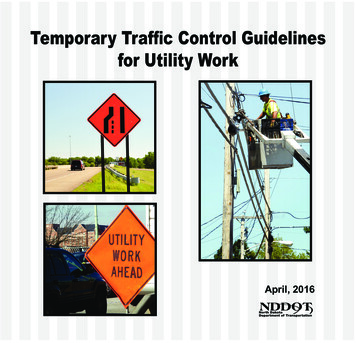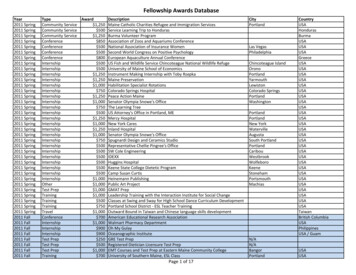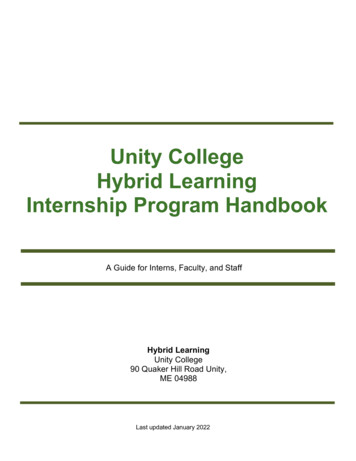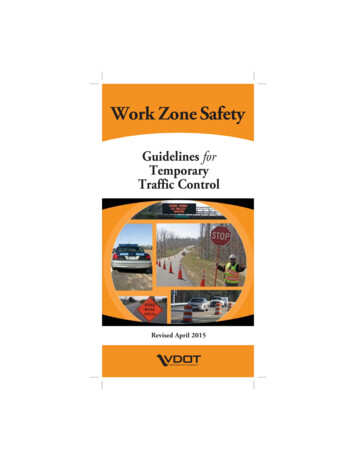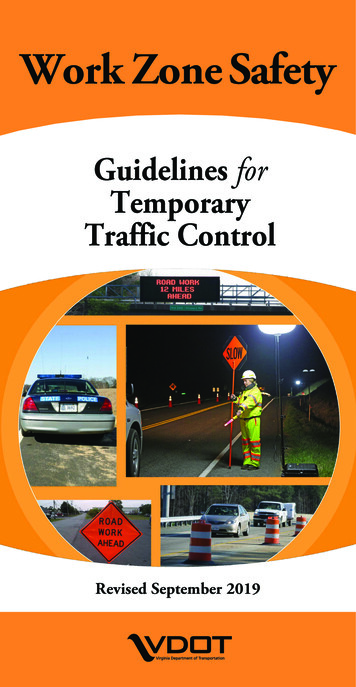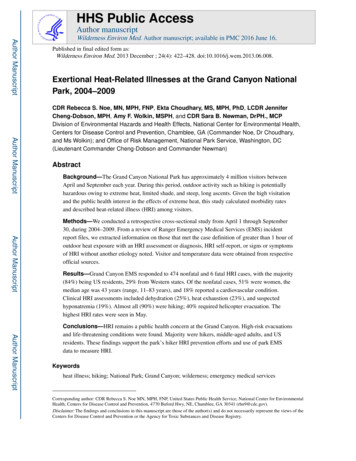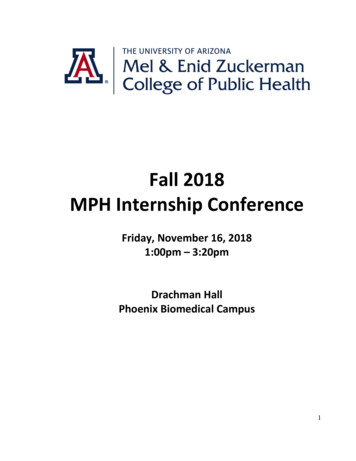
Transcription
Fall 2018MPH Internship ConferenceFriday, November 16, 20181:00pm – 3:20pmDrachman HallPhoenix Biomedical Campus1
2
ContentsPageAcknowledgements4Schedule of Events5Presenters6Presenters’ Email Addresses8Presenter Schedule9PresentationsSession ISession IISession IIISession IV10121315AbstractsSession ISession IISession IIISession IV17252937Drachman Hall MapThe MPH Internship Experience44453
AcknowledgementsAll of our wonderful internship sitesthroughout the state, nation, and world withwhom we work to improve the state of public healthThe students and faculty of MEZCOPH,who are central to the success of the MPH ProgramThe Office of Student Services and Alumni Affairsfor their outstanding efforts, support, and encouragementInternship Conference VolunteersWe would like to thank all of the volunteers for their timeand effort in making this a wonderful eventConference Planning CommitteeSidney Thigpen Dora Valencia Manpreet Sahnan Katey Redmond Niraly Patel Alexandrina Wallace Joey Fong Jessica Seline Tori DavisOffice of Student Services and Alumni AffairsKim BarnesTanya NemecGisela OchoaChris Tisch, Assistant Dean4
Schedule of Events1:00p-3:00pSession I:Session II:Session III:Session IV:3:00p-4:00p:Student Internship Presentations(Tucson-Drachman Hall A; Phoenix-Biomedical CampusBuilding 2)Drachman Hall, Room A116Phoenix Building 2, Room 2306Phoenix Building 2, Room 2208Drachman Hall, Room A118Drachman Hall, Room A120Reception(Walkway of Wellness, Tucson)5
PresentersNameConcentration*Room**TimePageMelody BertschHSAA116/PHX 23061:40 PM20Travis ConnorsEPIA1182:00 PM33Jamaica DillardEOHA1202:00 PM41Christina (Lauren) ErdelyiPHPMA1183:00 PM36Layla GabirEOHA1201:40 PM40Camille GonzalezFCH MCHA1181:00 PM30Krithiga GopiHSAA116/PHX 23063:00 PM24Magdiel HabilaEPIA1182:20 PM34Chelsey HarrisHSAA116/PHX 23061:20 PM19Sana KhanEPIA1201:00 PM38Kara KronemeyerPHPPHX 22081:00 PM26Emily MaassPHPMA116/PHX 23061:00PM18Gabriel MancillasEOH IHA1202:20 PM42Rebecca MojardinHSAA116/PHX 23062:00 PM21Erik OrnelasEOHA1202:40 PM43Caitlin (Katey) RedmondFCH GlobalA1181:20 PM31Laura RileyEPIA1201:20 PM39Harneel SandhuEPIA1181:40 PM32Alexandra ShilenEPIA1182:40 PM35Sahajdeep SinghHSAA116/PHX 23062:40 PM23Juhyung SunHSA/MBAA116/PHX 23062:20 PM22Jane ToomeyPHPPHX 22081:20 PM27Mia WrightMDMPHPHX 22081:40 PM286
*Concentrations and Dual Degree Designations:BIOS – BiostatisticsEOH – Environmental and Occupational HealthEOH IH - Environmental and Occupational Health Industrial Hygiene TrackEPI – EpidemiologyFCH MCH - Family and Child Health Maternal and Child Health TrackFCH GLOBAL - Family and Child Health Global TrackHSA – Health Services AdministrationHBHP - Health Behavior Health PromotionMD/MPH- Medical Doctor/Master of Public HealthPHP - Public Health PracticePHPM – Public Health Policy & Management**Rooms:All “A” rooms listed are found on the first floor of Drachman Hall.Phoenix presentations are located in Biomedical Campus Building 2, Rooms 2306 and 2208.7
Presenters’ Email AddressesNameMelody BertschTravis ConnorsJamaica DillardChristina (Lauren) ErdelyiLayla GabirCamille GonzalezKrithiga GopiMagdiel HabilaChelsey HarrisSana KhanKara KronemeyerEmily MaassGabriel MancillasRebecca MojardinErik OrnelasCaitlin (Katey) RedmondLaura RileyHarneel SandhuAlexandra ShilenSahajdeep SinghJuhyung SunMia arizona.edu8
Presenters ScheduleTime1:001:201:402:002:202:403:00Session ISession IIA116/PHX 2306PHX 2208E. MaassK. KronemeyerC. HarrisJ. ToomeyM. BertschM. WrightR. MojardinJ. SunS. SinghK. GopiSession IIIRoom A118C. GonzalezK. RedmondH. SandhuT. ConnorsM. HabilaA. ShilenC. L. ErdelyiSession IVRoom A120S. KhanL. RileyL. GabirJ. DillardG. MancillasE. Ornelas9
Session I(Drachman Hall, Room A116 Phoenix Building 2, 2306)1:00LEVERAGING VALUE-BASED CARE TO ADDRESS THE SOCIALDETERMINANTS OF HEALTH IN MEDICAID POPULATIONS. E. Maass.University of Arizona, Tucson, U.S.A. MPH Internship Committee Chair:Leila Barraza JD, MPH. Site and Preceptor: Community Catalyst (NationalAcademy of Social Insurance) – Danielle Garrett, MPA.1:20IMPROVING COORDINATION NETWORKS FOR HOUSTON FLOODPREPARATION, MITIGATION, RESPONSE AND RECOVERY (HURRICANEHARVEY HOUSEHOLDS NSF PROJECT). C. Harris. University of Arizona,Tucson, U.S.A. MPH Internship Committee Chair: Gail Barker MBA, PhD.Site and Preceptor: Houston, TX – Dr. Sheryl McCurdy PhD, M.Phil., MA,BA.1:40IMPROVING BREAST AND CERVICAL CANCER SCREENING RATES FORWOMEN IN A FEDERALLY QUALIFIED HEALTH CENTER (FQHC). M. Bertsch.University of Arizona, Tucson, U.S.A. MPH Internship Committee Chair:Gail Barker MBA, PhD. Site and Preceptor: Sun Life Family Health Center –Denise Atwood, JD.2:00TRIGGERS AND PERCEPTIONS OF DEPRESSION AMONG HISPANIC/LATINOEMERGING ADULTS ATTENDING COLLEGE. R. Mojardin. University ofArizona, Tucson, U.S.A. MPH Internship Committee Chair: Gail BarkerMBA, PhD. Site and Preceptor: Juntos por la Salud Mobile Unit- Phoenix –Eduardo Gonzalez, PhD.2:20FACILITATION AND ACTIVATION OF COMPLIANCE STRATEGY IN A HEALTHCARE DELIVERY SYSTEM. J. Sun. University of Arizona, Tucson, U.S.A. MPHInternship Committee Chair: Gail Barker MBA, PhD. Site and Preceptor:Kaiser Permanente – Sabrina Gill, MS.10
2:40PHOENIX CHILDREN’S HOSPITAL. S. Singh. University of Arizona, Phoenix,AZ, U.S.A. MPH Internship Committee Chair: Gail Barker MBA, PhD. Siteand Preceptor: Phoenix Children’s Hospital – Melissa Warden, RN, JD.3:00EVALUATION OF PATIENT PLACEMENT THROUGHOUT PROCESS USINGELECTRONIC BED BOARD IN PHOENIX CHILDREN’S HOSPITAL. K. Gopi.University of Arizona, Phoenix, U.S.A. MPH Internship Committee Chair:Gail Barker MBA, PhD. Site and Preceptor: Phoenix Children’s Hospital –Melissa Warden RN, JD.11
Session II(Phoenix Building 2, Room 2208)1:00CALLER DESCRIPTIONS OF SEIZURE-LIKE SYMPTOMS IN 911 OUT-OFHOSPITAL CARDIAC ARREST CALLS. K. Kronemeyer. University of Arizona,Phoenix, U.S.A. MPH Internship Committee Chair: Gail barker MBA, PhD.Site and Preceptor: Arizona Emergency Medicine Research Center(AEMRC) – Micah Panczyk, PhD1:20CONGENITAL SYPHILIS AND FETAL DEMISE IN MARICOPA COUNTY, AZ. J.Toomey. University of Arizona, Phoenix, U.S.A. MPH InternshipCommittee Chair: Douglas Campos-Outcalt MD, MPA. Site and Preceptor:Maricopa County Department of Public Health – John Keenan, PhD,MSPH.1:40THE LONG TERM EFFICACY OF A BEHAVIORAL BASED DIABETESPREVENTION PROGRAM FROM HIGH RISK HISPANIC YOUTH. M. Wright.University of Arizona, Phoenix, U.S.A. MPH Internship Committee Chair:M. Moe Bell MD. Site and Preceptor: Virginia G. Piper St. Vincent de PaulMedical Clinic – Maurice Lee, MD, MPH, FAAFP.12
Session III(Drachman Hall, Room A118)1:00BARRIERS AND FACILITATORS TO CARE FOR PERINATAL MOODDISORDERS AFTER REFERRAL BY A NURSE-FAMILY PARTNERSHIP NURSE.C. Gonzales. University of Arizona, Tucson, U.S.A. MPH InternshipCommittee Chair: Irma Ramos MD. Site and Preceptor: Nurse-FamilyPartnership – Teresa Wilson, MS, APRNC-OB, CNS BC.1:20DEVELOPING COMMUNITY LEVEL INTERVENTIONS TO REDUCE MALARIAAND HIV IN RURAL RWANDA. K. Redmond. University of Arizona, Tucson,U.S.A. MPH Internship Committee Chair: John Ehiri PhD, MPH. MSc. Siteand Preceptor: Inshuti Mu Buzima/Partners in Health – Jean D’AmourNdahimana, MD, MSc.1:40ASSESSMENT OF MARIJUANA-RELATED EMERGENCY DEPARTMENT VISITS& HOSPITALIZATIONS POST-LEGALIZATION IN RIVERSIDE COUNT, CA. H.Sandhu. University of Arizona, Tucson, U.S.A. MPH Internship CommitteeChair: Yann Klimentidis PhD, MS. Site and Preceptor: Riverside County, CA– Wendy Hetherington, MPH.2:00IDLE LESS FOR A HEALTHY SCHOOL ENVIRONMENT. T. Connors. Universityof Arizona, Tucson, U.S.A. MPH Internship Committee Chair: Robin HarrisPhD, MPH. Site and Preceptor: Pima County Department ofEnvironmental Quality – Beth Gorman, MPA, BA.2:20THE EFFECT OF HORMONE RECEPTOR STATUS ON BREAST CANCERTREATMENT IN DAR ES SALAAM, TANZANIA. M. Habila. University ofArizona, Tucson, U.S.A. MPH Internship Committee Chair: ElizabethJacobs PhD. Site and Preceptor: Dar es Salaam, Tanzania – Khadija Msami,MD.13
2:40OPIOID OVERDOSE PREVENTION IN PIMA COUNTY. A. Shilen. Universityof Arizona, Tucson, U.S.A. MPH Internship Committee Chair: ElizabethJacobs PhD. Site and Preceptor: Pima County Health Department – RaulMunoz, BS.3:00ORGANIZATION AND PROGRAMMATIC ASSESSMENT FOR SOUTHERNARIZONA ROADRUNNERS. C. L. Erdelyi. University of Arizona, Tucson,U.S.A. MPH Internship Committee Chair: Maia Ingram MPH. Site andPreceptor: Southern Arizona Roadrunners – Dari Duval, MS.14
Session IV(Drachman Hall, Room A120)1:00REDUCING THE RATE OF HEALTHCARE ACQUIRED INFECTIONS AT KAISERPERMANENTE WASHINGTON REGION. S. Khan. University of Arizona,Tucson, U.S.A. MPH Internship Committee Chair: Elizabeth Jacobs PhD.Site and Preceptor: Kaiser Permanente Washington Region – Capitol HillCampus – Elizabeth Rowan, RN, MSN, MBA.1:20DEVELOPMENT OF WELL WOMAN HEALTHCHECK PROGRAM’S PATIENTQUESTIONAIRE. L. Riley. University of Arizona, Tucson, U.S.A. MPHInternship Committee Chair: Elizabeth Jacobs PhD. Site and Preceptor:Pima County Health Department – Laura L. Hopkins BS, MS.1:40AN INDUSTRIAL HYGIENCE INTERNSHIP AT RISK MANAGEMENT SERVICES:EXPOSURE ASSESSMENT OF 3D PRINTERS. L. Gabir. University of Arizona,Tucson, U.S.A. MPH Internship Committee Chair: Jeff Burgess MD, MS,MPH. Site and Preceptor: Risk Management Services – John Murphy,MPH, CSP.2:00MOSQUITO SURVEILLANCE IN PIMA COUNTRY, ARIZONA. J. Dillard.University of Arizona, Tucson, U.S.A. MPH Internship Committee Chair:Stephanie Griffin PhD, CIH. Site and Preceptor: Pima County HealthDepartment – Amanda Anderson, MPH.2:20SAFETY PLANS, ENVIRONMENTAL SITE ASSESSMENTS AND INDUSTRIALHYGIENE EVALUATIONS WITH A NATIONAL CONSULTING FIRM. G.Mancillas. University of Arizona, Tucson, U.S.A. MPH InternshipCommittee Chair: Stephanie Griffin PhD, CIH. Site and Preceptor:Terracon Consultants, Inc. – Michael S. Crandall, MS, BS, CIH, LEED AP.15
2:40CHLOROHEXIDINE GLUCONATE BATHING COMPLIANCE IN MRSA POSITIVEPATIENTS AT ST. MARY’S HOSPITAL. E. Ornelas. University of Arizona,Tucson, U.S.A. MPH Internship Committee Chair: Mary Kay O’Rourke PhD.Site and Preceptor: St. Mary’s Hospital Infection Prevention and ControlDepartment – Erica McClain, RN.16
Session I:1:00 – 3:20Drachman Hall, Room A116 / Phx Building 2,Room 2306Abstracts17
LEVERAGING VALUE-BASED CARE TO ADDRESS THE SOCIAL DETERMINANTS OFHEALTH IN MEDICAID POPULATIONS. E. Maass. University of Arizona, Tucson,U.S.A. MPH Internship Committee Chair: Leila Barraza JD, MPH. Site andPreceptor: Community Catalyst (National Academy of Social Insurance) –Danielle Garrett, MPA.Access to consistent and quality health care coverage is essential to individualand population health. Medicaid is a cost-effective program that provides accessto healthcare services for millions of Americans each year. Medicaid is funded byboth federal and state governments, but is managed at the state level. Withapproval by the federal government, states are sometimes given flexibility toimplement Medicaid programs that fit the needs of their populations. Somestates look to policy changes to minimize the cost of operating the program andothers look to innovative Medicaid policies for new strategies to improve accessand quality of care. Through a review of policy briefs, legislation, and academicresearch, I identified reactive and proactive cost containment measures thatpublic health advocates can put forward to contain state Medicaid costs whileimproving care coordination and overall quality of care through value-basedpayment methods. The first brief evaluates reactive cost containment strategiesthat advocates could use to improve the Medicaid delivery system in statesaiming to curb Medicaid spending. The second policy brief outlines proactivepolicy measures that could be used to achieve long-term cost savings throughthe use of Medicaid dollars to address the nonmedical factors thatdisproportionately impact low-income Americans.18
IMPROVING COORDINATION NETWORKS FOR HOUSTON FLOOD PREPARATION,MITIGATION, RESPONSE AND RECOVERY (HURRICANE HARVEY HOUSEHOLDS NSFPROJECT). C. Harris. University of Arizona, Tucson, U.S.A. MPH InternshipCommittee Chair: Gail Barker MBA, PhD. Site and Preceptor: Houston, TX – Dr.Sheryl McCurdy PhD, M.Phil., MA, BA.Introduction: Hurricane Harvey of 2017 was not just a catastrophic event, butwas also the cap on a cumulative 17-year series of flood and is tied withHurricane Katrina as one of the costliest tropical cyclones on record, due to itsdisastrous flooding. The Hurricane Harvey Households NSF Project was designedto determine whether past flood experience would reduce household conflict indecision-making, and whether flood-fatigued households had less conflict indecision-making during recovery. Methods: Mixed methods approaches allowedexamination of these decisions during disaster. Data collection included in-depthinterviews, field notes, and archival sources (newspaper reports, internet sitesdedicated to Hurricane Harvey evacuees, government and NGO reports). Keyinformants, stakeholders affiliated with Houston government agencies, nonprofit groups, and religious organizations, were also interviewed. Interviewswere transcribed, then the files, field notes, and relevant documents were codedfor themes and emergent ideas that needed further exploration in laterinterviews. Results: As hypothesized, there were many differences regardingdecision-making between households with prior flood experiences and thosewithout. There were also substantial gender differences in decision-making inhouseholds. As suspected, gender household negotiations about recoverydecisions varied by a household’s community connectedness, socioeconomicstatus, and generational status. Conclusion: The Hurricane Harvey NSF Projectprovided insight into the types of interventions and policies that will helphouseholds remain viable in the face of disaster, examining the processes of riskassessment, coping, and survival strategies in households following majornatural disaster.19
IMPROVING BREAST AND CERVICAL CANCER SCREENING RATES FOR WOMEN INA FEDERALLY QUALIFIED HEALTH CENTER (FQHC). M. Bertsch. University ofArizona, Tucson, U.S.A. MPH Internship Committee Chair: Gail Barker MBA, PhD.Site and Preceptor: Sun Life Family Health Center - Denise Atwood, JD.Introduction: Federally Qualified Health Centers (FQHCs) serve a variety ofunderserved populations, including a high percentage of uninsured andunderinsured members in at-risk communities. Adherence to screeningrecommendations for breast and cervical cancer is minimal. This study examinedthe effectiveness of Sun Life Family Health Center’s breast and cervical cancerscreening reminder process. Methods: Using the eClinicalWorks system, apopulation-based auditing system was developed to analyze the impact of breastand cervical cancer reminder letters on a randomly selected sample of 250patients between the ages of 21-64 years old. Split into two phases, Phase Iconsisted of 125 patients sent reminder letters, while an additional 125 patientsreceived no letters. Phase II was comprised of modifying the original letter andsending it to the 125 patients that did not receive a letter during the Phase I.Data collected was based on the type of letter sent and patient appointmentsmade during each phase. Results: Phase I yielded three patient appointmentsfrom the group receiving a letter and four appointments for patients whoreceived no letter. Phase II produced one patient appointment from the groupreceiving the modified letter and five appointments from patients who did notget a letter. The total yield from both phases was four patient appointmentsafter receiving a letter and nine appointments made regardless of getting aletter. Conclusions/Recommendations: Results demonstrated a minimaldifference in screening volume whether patients received a letter or not. Datashowed that a higher volume of patients made appointments regardless ofreceiving a letter. Recommended alternatives include contacting patients byemail, patient portal systems or text messaging, conserving manpower and otherresources.20
TRIGGERS AND PERCEPTIONS OF DEPRESSION AMONG HISPANIC/LATINOEMERGING ADULTS ATTENDING COLLEGE. R. Mojardin. University of Arizona,Tucson, U.S.A. MPH Internship Committee Chair: Gail Barker MBA, PhD. Site andPreceptor: Juntos por la Salud Mobile Unit- Phoenix - Eduardo Gonzalez, PhD.Introduction: This project examined the impact of the country's current politicalclimate and immigration policies on the Hispanic/Latino community byidentifying triggers and perceptions of mental health among Hispanic/Latinostudents attending college. Methods: This study was designed to obtain datathrough the facilitation of two focus groups and administration of an onlinesurvey. All students were recruited from the Ana & Adalberto Guerrero studentcenter at the University of Arizona. The online survey was sent through thestudent center's weekly announcements email. Students who subscribed to thislistserv received the survey link and focus groups dates. Results: 34 students(91% female, 9% male) responded to the online survey; no students attendedthe focus groups. The respondents self-identified as 88% Hispanic/Latino, 9%White/Caucasian and 3% Native American/American Indian. The resultsindicated that 88% of all respondents thought the Hispanic/Latino communityexperienced more stressors or triggers, which could affect mental health whencompared to other groups. Results point to triggers in the areas of employment,living environment and financial instability. However, the largest stressor/triggeridentified as affecting mental health was immigration. This was reported by 33%of all respondents. Participants also described their perceptions of whatconstituted mental health. Summary: The main purpose of this project was toshare these findings and recommend a solution to bridge the gap betweencampus mental health and students. The potential for future research, as well asthe limitations of this study, including low overall participation and the lack ofattendance at the focus groups, will be discussed in the presentation.21
FACILITATION AND ACTIVATION OF COMPLIANCE STRATEGY IN A HEALTH CAREDELIVERY SYSTEM. J. Sun. University of Arizona, Tucson, U.S.A. MPH InternshipCommittee Chair: Gail Barker MBA, PhD. Site and Preceptor: Kaiser Permanente Sabrina Gill, MS.Introduction. The National Office of Ethics, Compliance, and Integrity (NCO) atKaiser Permanente oversees compliance issues across the Hospital and HealthPlan entities. This internship took place within Compliance Strategy, a group thathelps the NCO set strategic initiatives; the primary focus was on communicatingthe NCO Strategic Agenda, constructing metrics to assess Strategic Agendaprogress, and identifying NCO knowledge management solutions. Methods.Communicating the Strategic Agenda involved hearing feedback on prior learningmodules constructed for this purpose, learning best practices for modules, andworking with NCO groups to draft and publish modules internally. Constructingmetrics involved learning current process measures, researching best practices,drafting potential metrics, and identifying next steps. Identifying knowledgemanagement solutions involved researching best practices, interviewing NCOcolleagues on needs, and identifying next steps. Results. For communicating theStrategic Agenda, deliverables included a learning module, best practicestemplate, and framework for aligning prior modules to best practices. Forconstructing metrics, deliverables included two metric sets, a best practicesdocument, and recommended next steps. For identifying knowledgemanagement solutions, deliverables included a research summary, interviewresults across the NCO, and recommended next steps. Conclusion. Keychallenges in completing deliverables included competing priorities, the timerequired for stakeholder consensus, and the discovery (through backgroundresearch) of new key questions to be answered. All three projects related toneeds that are general across all organizations (strategy, metrics, andknowledge); importantly, each requires a robust infrastructure for fullimplementation.22
PHOENIX CHILDREN'S HOSPITAL. S. Singh. University of Arizona, Phoenix, AZ,U.S.A. MPH Internship Committee Chair: Gail Barker MBA, PhD. Site andPreceptor: Phoenix Children's Hospital - Melissa Warden, RN, JD.Introduction: Phoenix Children’s Hospital is one of the largest pediatric hospitalsin the country. The hospital offers several subspecialties and houses a variety ofoutpatient clinics to provide families both convenience and the best care. Thegoal of this project was twofold; a) to create a resource guide and onboardingchecklist for new ambulatory practice managers and b) to align reports tomeasure the associated metrics. Methods: A team of five practice managers wasrecruited to help create the guide. Each member was assigned a category toensure that all sections included the objectives each practice manager wouldneed to complete. Next, the team discussed metrics related to each objectiveand the best report for the metric. Lastly, all of the remaining clinic reports werestudied to determine whether or not they should be included in the guide. Theonboarding checklist was developed using the resource guide. The checklist wasdesigned to help new managers self-assess their skills, whether acquired duringthe PCH hiring process or from previous training. Results: Practice managers atPCH are highly qualified, however, many of the practice managers recommendedthat more effective training take place at orientation. They also recommended acentral location for clinic reports be identified. The resource guide and theonboarding checklist were very well received by practice managers and leadersthroughout the hospital. Conclusion: Practice managers can benefit from havinga well-defined resource guide and onboarding checklist. However, it is highlyrecommended that both of these documents be updated as the needs of clinicoperations change. Furthermore, it is recommended in the future reports shouldbe consolidated into dashboards based on the metric and outdated reportsshould be archived.23
EVALUATION OF PATIENT PLACEMENT THROUGHPUT PROCESS USINGELECTRONIC BED BOARD IN PHOENIX CHILDREN’S HOSPITAL. K. Gopi. Universityof Arizona, Phoenix, U.S.A. MPH Internship Committee Chair: Gail Barker MBA,PhD. Site and Preceptor: Phoenix Children's Hospital - Melissa Warden RN, JD.BACKGROUND: Phoenix Children’s Hospital (PCH), one of the largest children’shospital in the country, has 433 beds and admitted approximately 13,000patients last year. The hospital planned an initiative to improve their patientthroughput and patient care experience by replacing their whiteboards withelectronic bed boards. The goal of this initiative was to improve inpatientplacement time and ease the admission and discharge process. METHODS: Thedata was collected over a period of 3 consecutive months – June to August 2018.This timeframe covered the pre-intervention period, transition period and thepost-intervention period. Metrics were developed, and the data was abstractedfrom the hospital central database and from the teletracking application. Thedata was analyzed to determine the success of the electronic bed boardimplementation using graphs and a scorecard. RESULTS: There was a significantimprovement in the average patient placement time, the average ED and PACUhold and the number of patients discharged before 11 am and 2 pm. However,the room turnaround time, level of care and phone calls to hospital admissioncenter did not improve. CONCLUSIONS: This intervention improved many patientcare metrics, yet some metrics remained unchanged especially the hospitaladmission center phone talk time. This intervention has the potential to improveother patient care metrics such as decreasing patient length of stay. Periodicassessment to determine the patient care metrics should be conducted toimprove the patient experience. It was suggested PCH implement a dashboard,which would automatically generate these metrics.24
Session II:1:00 – 2:00Phx Building 2, Room 2208Abstracts25
CALLER DESCRIPTIONS OF SEIZURE-LIKE SYMPTOMS IN 911 OUT-OF-HOSPITALCARDIAC ARREST CALLS. K. Kronemeyer. University of Arizona, Phoenix, U.S.A.MPH Internship Committee Chair: Gail Barker MBA, PhD. Site and Preceptor:Arizona Emergency Medicine Research Center (AEMRC) - Micah Panczyk, PhD.Background: Out-of-hospital cardiac arrest (OHCA) is a major public healthconcern. Bystander cardiopulmonary resuscitation (BCPR) significantly improvessurvival and telecommunicator CPR (TCPR) increases the rates of BCPR further.Identifying opportunities for 911 telecommunicators to initiate CPR sooner mayincrease survival rates. For callers reporting seizure-like symptoms, TCPR may bedelayed. Identifying circumstances where callers describe seizure-like symptomsmay lead to important information to be used by medical dispatch centers.Methods: A total of 429 EMS-confirmed OHCA calls from three regional 911centers in Arizona were reviewed for years 2013 to 2016. All calls were reviewedfor the frequency of specific terms used by callers to describe seizure-likesymptoms. Descriptive statistics were performed on preliminary findings.Results: There were 389 calls after exclusions. Of these, 17 (4.6%) had seizurelike behavior described by the caller. For 76.5% (n 13) of this subgroup, thecaller used the term “seizure.” The second most common term used was“shaking” (11.8%, n 2). The median time to describe seizure-like symptoms was28 seconds (IQR 0:18, 0:42). Telecommunicators started seizure interventions for35.3% (n 6). In all 6 calls, seizure intervention was started prior to TCPR beinginitiated. Conclusion: The number of calls identified having seizure-liketerminology used by the caller was small. Nearly all callers used the word“seizure” to describe seizure-like symptoms in the patient. In all cases whereseizure intervention was initiated, seizure intervention was started prior to TCPR.Recommendations: A limitation was the small number of seizure calls identifiedfor review. It is recommended more EMS-confirmed OHCA telecommunicatorcalls be reviewed in order to complete a more thorough analysis.26
CONGENITAL SYPHILIS AND FETAL DEMISE IN MARICOPA COUNTY, AZ. J.Toomey. University of Arizona, Phoenix, U.S.A. MPH Internship Committee Chair:Douglas Campos-Outcalt MD, MPA. Site and Preceptor: Maricopa CountyDepartment of Public Health - John Keenan, PhD, MSPH.Introduction There were 147 congenital syphilis cases in Maricopa County from2008 to June 1, 2018; 13 of these resulted in fetal demise (8.8%)1. In the sametime period Maricopa County and Arizona have had higher rates of congenitalsyphilis (CS) than the national average2. The aim of this internship was to findrisk factors associated with fetal demise from congenital syphilis. MethodsDemographic and risk factor data were obtained from case investigations of CS.Those with fetal demise were compared to others. Continuous variables werecompared by a t-test; categorical values were compared by a chi-square orFisher’s Exact, when indicated. Results Lack of prenatal care (p 0.003) and ayounger gestational age (p 0.001) were significantly related to fetal demise;all other factors showed no statistical significance. Conclusion Congenital syphilisis a preventable disease eliminated through proper screening, testing, andtreatment. ARS 36-693 mandates syphilis testing during the first prenatal visit.Prenatal care was the only preventive measure significantly associated inverselywith adverse birth outcomes. These results demonstrate the need for educationand disease prevention efforts among pregnant women to reduce the risk offetal demise from CS. 1. Maricopa County, AZ. Unpublished Data 2. Center forDisease Control and Prevention. Sexually Transmitted Disease Surveillance 2016.https://www.cdc.gov/std/stats16/CDC 2016 STDS Reportfor508WebSep21 2017 1644.pdf Published September 2017. Accessed August2018.27
THE LONG TERM EFFICACY OF A BEHAVIORAL BASED DIABETES PREVENTIONPROGRAM FOR HIGH RISK HISPANIC YOUTH. M. Wright. University of Arizona,Phoenix, U.S.A. MPH Internship Committee Chair: M. Moe Bell MD. Site andPreceptor: Virginia G. Piper St. Vincent de Paul Medical Clinic - Maurice Lee, MD,MPH, FAAFP.Intro: Little is known about the long term efficacy of diabetes preventionprograms that target high risk youth. The purpose of this project was todetermine the long-term efficacy of a behavioral & medical program targeted athigh risk youth. At the St. Vincent de Paul Medical & Dental Clinic (SVdP), theEvery Little Step Counts (ELSC) diabetes prevention program has recruited highrisk Hispanic youth to participate in 12 bi-weekly classes since 2005. Methods: 21adolescents who completed ELSC were recruited as the intervention group. 9youth in the community who did not complete the program were recruited asthe control group. The HbA1c, BMI% and BP were measured & they all took ahealth questionnaire. Results: There was no significant difference in A1c%(p 0.87), Systolic BP and BP% (p 0.21 and p 0.29), BMI% (p 0.11) and healthbehaviors (p 0.05) between adolescents who completed the program versusthose who
and Preceptor: Phoenix hildren's Hospital - Melissa Warden, RN, JD. 3:00 EVALUATION OF PATIENT PLACEMENT THROUGHOUT PROCESS USING ELETRONI ED OARD IN PHOENIX HILDREN'S HOSPITAL. K. Gopi. University of Arizona, Phoenix, U.S.A. MPH Internship Committee Chair: Gail arker MA, PhD. Site and Preceptor: Phoenix hildren's Hospital -

